Cornell University’s Project FeederWatch, sponsored by the Lab of Ornithology, is one of the continent’s most popular citizen science projects. New volunteers are always welcome.
FeederWatch project director Dr. Emma Grieg, reminded me recently via phone that anyone can participate.
“Our materials teach everything participants need to know. Even counts of common birds such as cardinals and chickadees are useful. And volunteers don’t need to identify every species they see.” she said.
If volunteers have questions or problems, they are encouraged to contact FeederWatch staff by email or phone.
“We love hearing from volunteers to make their experience more rewarding,” Grieg says.
Assuming you have suitable habitat with some woody cover, you can expect 12 to 20 species to visit feeders over the course of the winter.
Submitted data
Based on data submitted from FeederWatchers in the Northeast Region, which extends north and east from Kentucky, last year the most frequently seen species were Carolina and black-capped chickadees.
Rounding out the top ten most frequently reported species in the region were dark-eyed juncos, downy woodpeckers, mourning doves, blue jays, northern cardinals, American goldfinches, white-breasted nuthatches, house finches and American robins.
“With almost 30 years of data from all across the country,” Grieg says, “we have more data than any one ornithologist could ever collect. And now we publish our findings in peer-reviewed scientific journals.”
Last summer Greig and her colleague David Bonter, Cornell’s director of citizen science, presented the results of FeederWatch at the North American Ornithological Conference.
Among FeederWatch’s objectives is to determine if supplemental feeding benefits birds.
They examined 30 years of FeederWatch data collected by thousands of volunteers and selected 135 species that use feeders occasionally to regularly.
Population trends
Then they compared population trends for those species over 50 years of Christmas Bird count data. They found that populations of birds that use feeders were doing fine over time.
The few feeder species showing population declines were non-native species such as house sparrows and European starlings. Species suffering the most serious populations declines such as seabirds and shorebirds don’t come to feeders.
The bottom line is that populations of birds that use feeders are healthy.
Furthermore, Grieg and Bonter conclude that, “the act of feeding backyard birds may inspire people to support conservation.” Another important benefit of FeederWatch is that the army of skilled birders grows every year.
Report data
Collecting the data is fun, and can be done with children and grandchildren. And it does not require a burdensome time commitment. Even if you report data just once all winter long, the information is useful.
But taking 15 minutes every Saturday morning while enjoying a cup of coffee is hardly a chore.
Launched in 1987, Project FeederWatch compiles information gathered by volunteers from all across North America. Last year 22,082 volunteers submitted 140,034 checklists and reported a staggering 6,775,487 birds.
Join
To become a FeederWatch volunteer visit www.feederwatch.org or call 800-843 2473 during normal business hours, or send a check to Project FeederWatch, P.O. Box 11, Ithaca, NY 14851-0011.
The $18 fee, or $15 for Lab of Ornithology members, covers all materials, data analysis and publication of each year’s results.
To celebrate the 30th anniversary of FeederWatch, Wild Birds Unlimited is offering to offset the membership fee by offering $15 off any $50 purchase at participating stores.
Participants will receive details for how to redeem this discount on their FeederWatch registration receipt.
Suet cakes
As we celebrate Thanksgiving today, it’s time to prepare suet cakes for chickadees, nuthatches and woodpeckers.
My favorite peanut butter suet recipe comes from Alabama birder Martha Sargent.
The ingredients include; one cup crunchy peanut butter, one cup lard (no substitutes here), two cups “quick cook” oats, two cups cornmeal, one cup white flour and one-third cup sugar.
Optional ingredients include; a few raisins, sunflower kernels, and/or shelled peanuts.
Directions: Melt lard and peanut butter in microwave or over low heat, then stir in remaining ingredients.
Pour into square freezer containers about 1.5 inches thick. Chill in freezer for 30 minutes, then cut to size, separate blocks with wax paper, and store in freezer.













